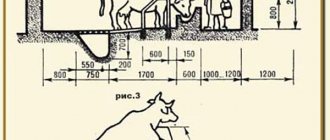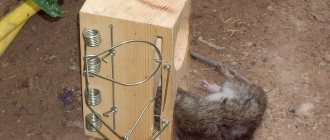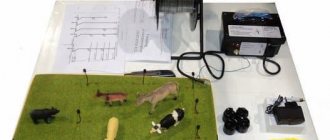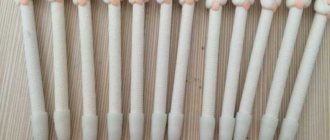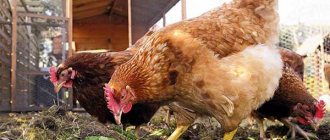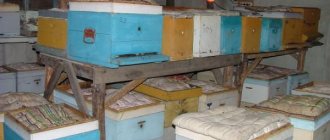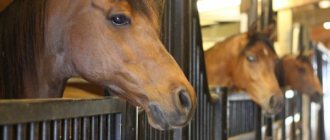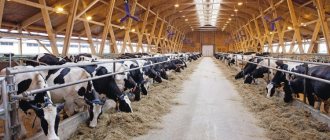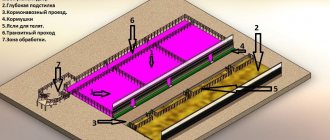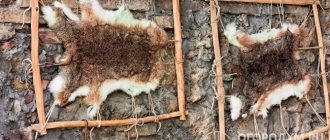Requirements for the house
Before you start building a house for rabbits, you need to find out what types of structures are used when breeding animals:
1. Pit structure. This is a pit 1–2 m deep, the walls and floor of which are concreted. You need to leave space at the bottom of one of the walls for rabbits to dig holes. It is believed that pets in pits have strong immunity, develop and reproduce faster. However, it is difficult to control the condition of each animal and their mating; pets can escape through dug holes.
2. All-season house. This group includes various designs for rabbits that are placed in a heated room, or insulated houses.
3.Mini farm. This is a large (two- or three-story) house for animals on legs, the height of which reaches 1 m. The structure can accommodate about 40 animals, and it can also be increased in length. The buildings are designed in such a way that the supply of food, water and cleaning are automated.
4.Group design. This is a simple cage that consists of a compartment for resting and walking. It is intended for rabbits under 6 months.
5.Queen cell. This is a simple design for pregnant females, which looks like a box with a separate hole and a nest inside. The queen cell is necessary for the period of birth (one week before it) and for 20 days after birth.
Two-section cages are needed for males who will not share the territory with other rabbits.
Interesting! There are 2 types of free-range keeping of rabbits: grazing and aviary. In the first case, the animals receive pasture, in the second, from a feeder. This method of breeding is considered the most natural. However, when kept freely, epidemics often occur, animals are attacked by predators, pets run away, and it is impossible to control mating. In addition, the meat of “free” animals is coarser.
For this reason, it is better to build a house for your rabbit to protect it from danger. This design must meet the following requirements:
- The home for a lagomorph must be spacious so that it can stand on its hind legs without touching the ceiling. If there is no space for such a building, then you should walk your pet regularly.
- Housing for rabbits should be four times larger than its parameters. That is, it is recommended to create a house “for growth”.
- It is worth choosing high-quality and environmentally friendly materials for your home. The best option is wood untreated with toxic substances.
- The floor in the house should be made of fine lattice or mesh, and under it you should place a tray into which feces will fall. You can also place a feces tray with a hard mat, the corners of which should be folded so that the rabbit does not get hurt.
- It is necessary to leave space in the house for feeders and drinkers.
- The door in the cage should be wide so that the rabbit can be reached without any problems.
- Houses for rabbits should be raised to a height of up to 70 cm to prevent predators from getting inside.
- It is better to make the walls of the house from wood (plywood and boards). For exterior finishing, plastic or wooden slats are used.
- It is recommended to install 2 doors (mesh and board) at the front of the house to make the cage easier to maintain.
- The roof frame is made of the same material as the walls. To protect it from atmospheric influences, it is covered with a layer of roofing felt and/or slate.
- All wooden elements of the house that are accessible to rabbits should be sanded to prevent the rabbits from being injured.
Attention! When building a house for pets, it is not recommended to use metal. This material gets very hot during hot weather and can cause discomfort for rabbits. In winter, the animal can freeze to cold metal.
A good home should be comfortable and safe for rabbits, and easy to maintain. It would be great if the cage is equipped with an automated system for watering, feeding, cleaning and waste disposal.
It is also important to study the requirements for choosing a location for a rabbitry:
- According to building regulations, buildings housing pet rabbits (and other animals or birds) must have an area of up to 40 m² and be located 15 m or more from the house.
- You should choose an elevated place with moderate humidity for your house.
- The rabbitry should not be installed in a windy place. If there is no other choice, then the house is installed indoors. Or they put up fences to prevent it from blowing through.
- Groundwater on the site for the house should be at a depth of 1.5 m or more. To check this, you need to make a hole in the ground with a garden drill.
- The soil in the area for the rabbit house should be loose. Dense and clayey soil retains rain and melt water.
The right place for a rabbit's home is the key to their comfort and long service life of the structure.
Shape and dimensions
Typically, domestic rabbits, which are bought as pets, live in small cages: width - from 40 cm, length - from 70 cm. Such a house is suitable for decorative lagomorphs. Average cage dimensions: width – 45 cm, length – 85 cm. The pet will feel more comfortable in a rabbitry up to 50 cm wide and about 100 cm long.
Interesting! Experienced rabbit breeders advise choosing a house individually for each animal, depending on its size.
Rabbits feel comfortable in two-story houses. On the first floor there is a tray, a feeder, a drinking bowl, and on the second there is a nest for sleeping. Both tiers are connected by a staircase along which the rabbit runs happily.
For a pair of adult rabbits, you need to choose a more spacious house: width - from 65 cm, length - from 155 cm, height - from 55 cm.
Materials
The safest material for a rabbit's house is wood. Only the wood should not be covered with paints and varnishes that will cause intoxication in the pet.
Wood is used to make the frame, walls and ceiling of the house. The door can be covered with mesh so that air and light penetrate through it, and the rabbit has a good view.
Wood retains heat well, especially if the walls are made double and additionally insulated. Such a house will protect not only from cold, but also from overheating.
A wooden house has several disadvantages: it is heavy, and rabbits can chew on the elements available to them. If the owner is going to frequently move the home, then it is better to purchase a lightweight plastic structure. But it is not suitable for outdoor use. If the wooden house will be located in a heated room, then it is recommended to cover the elements accessible to rabbits with sheets of metal.
If you live in an apartment, you can make a house out of metal. This can be a galvanized grid or mesh that is stretched over a wooden frame. However, such a cage does not protect against heat, cold and wind, so it must be placed in a heated room. Additionally, you can make a shelter for it, for example from a cardboard box. Such a house is lightweight, so it can be moved from place to place.
The tray for the mesh cage should be made of plastic. Its optimal depth is about 15 cm.
Useful tips for keeping rabbits
Decorative rabbits are quite capricious creatures, which in their pampering are superior to even their larger relatives. They respond painfully to any changes in the microclimate and are very sensitive to low-quality food, therefore, in addition to home improvement, it is also worth knowing about the rules for caring for these fluffies.
Here are some of the most common recommendations:
- Place the cage with the animal only in a room with a constant air temperature within +18...+22 °C and a complete absence of drafts.
- Make sure that other pets (especially cats and dogs), as well as small children, do not have access to your long-eared pet, because they can not only stress him out, but also cause physical harm.
- Never pick up a rabbit by the ears or the withers: this causes significant discomfort and can even frighten him.
- Always maintain the temperature within optimal limits, avoiding overheating of animals (this harms them even more than lower temperatures). As a last resort, if there is no other suitable place in the room, and the sun's rays fall on the cage, cover it with a damp towel and regularly wipe the animal's ears with a clean, cold, damp cloth (there should always be drinking bowls with cold water or even ice in the cage itself) .
- When ventilating the room, it is better to temporarily move the rabbit to another room, placing it in the coolest corner.
- If you don't have time to completely clean the cage, at least clean the toilet to avoid toxic buildup.
- Organize walks for the animal around the apartment every day, and in the summer, take it out into the yard more often, only mainly in the evening (these nocturnal animals can sit quietly in a cage all day, becoming more active only with the arrival of night).
- Do not restrict the animal’s movements, otherwise it will begin to quickly gain weight and soon become obese, which will negatively affect its overall well-being.
- Long-haired pets will have to be additionally combed and their hair trimmed periodically to prevent it from matting.
- As they grow, it is necessary to trim the animals' claws, for which special nail clippers are designed.
- To feed your furry pets, choose only high-quality food, possibly containing probiotic substances (prevent the development of problems with the animal’s stomach). In addition to dry mixtures, it is useful to give rabbits an apple, a pear (in limited quantities) and vegetables prepared in the summer.
Building a rabbit house is not as difficult as many people think, but whatever option you choose, do not forget that this is just the beginning of your mission. For a comfortable life in it, the animal will need appropriate care, the basic rules of which you already know.
Making a house with your own hands
You need to make a house for a rabbit strictly according to plan:
- choose a place for housing;
- draw up a project: draw a diagram of the house and indicate the structural elements and their dimensions;
- prepare materials and the necessary set of tools;
- assemble the structure.
Most often, rabbit breeders make wooden bunk houses for rabbits with their own hands. They are the most comfortable and durable. Beginners can choose a simple rabbitry model, while advanced ones can choose a more complex design.
If a decorative rabbit lives in an apartment, then you can make a cardboard house for it. It can be used as temporary housing.
Guide to making a cardboard house:
1. We prepare 2 boxes, the height of which is approximately 35 cm and the length is 45 cm. You will also need a graphite pencil, a compass, scissors and tape.
2.On the side of the box at the bottom, use a compass to mark a circle. Then we outline it with a pencil. This will be the entrance. You can do without a threshold and draw a circle that is cut off at the bottom.
3. We make the same openings on the two side (narrower) parts of the box. Only the back wall needs to be left intact.
4.Next, cut out the parts along the contour. It turns out 3 semicircles.
5. We turn the box over, laying its upper edges so that they do not open. We cover all joints with tape to make the structure more durable and stable.
6.Next, cut out 2 semicircles on the second box: the first on the side (as when preparing the first box), and the second in the middle. Then we seal all the joints on top with tape.
7.We connect both structures using adhesive tape so that the side holes inside coincide. They are needed to move the rabbit from one room to another.
If desired, the house can be decorated with drawings or self-adhesive paper.
Inside the house you need to lay out a bedding or waterproof mat. In one compartment they place a feeder, a drinker and a tray, and in the other the rabbit will sleep.
Preparation of the drawing
Beginning craftsmen can make a two-tier house for a dwarf rabbit with their own hands. It is quite spacious and mobile.
To make a house you can use the following scheme:
1.The dimensions of the structure can be changed depending on the parameters of the rabbit.
2.The owner of the animal can create his own drawing or take a ready-made template.
3.First, you should draw a diagram of the future house on paper, taking into account all the constituent elements (number of floors, doors and stairs), as well as dimensions.
Required materials and tools
To make a two-tier house for rabbits, you need to prepare the following materials:
- sheets of plywood: 2 thin and 3 medium thickness;
- beams or boards;
- metal grid;
- furniture legs;
- fasteners;
- glue.
To make a house, you can use old furniture or leftover building materials that are available on the farm.
To avoid problems during work, you need to prepare the necessary set of tools:
- electric saw;
- drill;
- construction stapler;
- brush;
- construction tape.
This kit is enough to build a comfortable two-tier house.
Photo report on the manufacture of a cage for a rabbitry from a galvanized profile
This option is suitable for those regions where wood is expensive or for those who have a lot of profile remains after construction/repair. When making cages, the dimensions are adjusted to the existing molding - small deviations in one direction or another are acceptable, but the rabbits should have room in the cage.
Frame assembled
This cage was built for a female with rabbits up to 20 days old. It consists of two sections. The main part is 55*75*55 cm, the mother liquor is 35*55*30 cm. The racks have a reinforced profile, the crossbars are used for normal work - as usual with drywall - the pieces are fastened with self-tapping screws (fleas).
Example of profile fastening
The floor in the main part is made of a block 2 cm thick and 5 cm wide. The planks are attached to the profile with self-tapping screws. The screws must be screwed in so that they can be easily unscrewed - if (or rather, when) the strip is chewed, it will be easy to replace with a new one.
The floor in the main part is cracked
In the queen cell the floor is solid, without cracks. If in winter you are not sure that your rabbitry will be warm enough, it is better to make a double floor in this part and fill the gap with insulation - even expanded clay. In this case, even with a sharp cold snap, the babies will not freeze - their mother usually warms them from above. If it is warm from below, they will not get sick.
The mother liquor is made without cracks
The height of the queen cell is 20 cm lower than the main cell. From the inside, in the cage, there is a shelf on which the rabbit will escape from the annoying little ones.
Everything is covered with plywood, view from the side of the cage
To prevent the external joints of the plywood from being chewed, we cover them with perforated metal corners. You just need to look for the ones that are thicker. We cut the edges of the corners at 45° so that they do not ride up or stick out.
All that remains is the covering of the main walls and the manufacture of the door. This is what should happen as a result
Manufacturing stages
To make a rabbit house, you need to follow this plan:
1. A rectangular piece is cut out of plywood, 70 cm long and 60 cm wide. It is connected to 4 beams 45 cm long. To do this, holes are made in them through which self-tapping screws are screwed.
2.A rectangle of the same size as the previous one is again cut out of plywood. This will be the base of the top floor. A square hole is made in its lower left part through which the rabbit will climb up. Its size depends on the size of the pet.
3.The base of the cage (part No. 1) is connected to the partition (part No. 2) using self-tapping screws.
4. On medium-thick plywood, mark 2 side walls, which have the following parameters: 60x92 cm. Then they are cut out with a saw.
5. The sides are fixed to the frame so that the structure is level.
6. 4 racks are made from the beams, which are attached to the base of the second tier with self-tapping screws. Then the sides are cut out of thick plywood and fixed to the frame. After connecting all the walls and ceiling, the structure is almost ready.
7. A piece measuring 1.2x6 cm is cut out of the board. This will be a threshold that will not allow food and bedding to spill out. It is fixed to the vertical supports below using self-tapping screws.
8.The frame for the door is made of boards. You need to cut out parts that fit the size of the cage. Wooden elements are connected using a stapler. If desired, the structure can be strengthened with steel corners.
9.The door frame is covered with a mesh, which is fixed with a stapler. Then the door is attached to the house on its hinges and a latch is installed.
10. The staircase is made of thin plywood. To do this, cut out a part whose height corresponds to the distance between the floor of the first floor and the ceiling of the second. It is installed at an angle so that the rabbit can climb up. The top of the stairs is covered with pieces of rubber or ice cream sticks. This is necessary so that the animal does not slip while climbing.
11.Furniture legs are attached to the bottom of the house. They must be stable.
Important! After the owner finishes building a house for rabbits, he must treat all surfaces with an antiseptic composition. This is a special water-repellent solution that protects wood from rotting. After applying it, the structure must dry under the sun.
If the structure will be located on the street, then you need to insulate the walls and make a high-quality roof. A pitched roof is suitable for weather protection. It is enough to stretch the roofing material onto the timber sheathing. The roofing material is secured using mounting strips, nails or self-tapping screws. Instead of roofing felt, you can use slate, sheets of metal or tiles.
For additional protection from moisture, a waterproofing film is laid under the roofing material. Then the house will be warmer and more comfortable.
Collection rules
In order for the animals to be as comfortable as possible in the manufactured house, it is necessary to follow certain rules during construction. It is advisable not to violate them:
- The protruding parts must be covered with tin.
- It is advisable to use slate for the roof.
- Under no circumstances should you use varnish or antiseptic for impregnation; rabbits will not like the smell.
- An extremely durable wooden beam is used as a frame.
- The back walls can be made of plywood.
When the drawing is completed and the materials are prepared, you can proceed to the actual construction. First of all, the frame is assembled, and then the mesh floor is laid.
If outdoor maintenance is planned, then the floor is insulated and a removable tray is installed underneath it. This is necessary for cleaning. Next, you can install the back wall, which is made of plywood. It is worth noting that it must be lower than the front one. The side walls can also be made from a sheet of plywood.
If the cage is planned to be double, then a hay barn is installed in the middle. The last wall is made of mesh, with a door. If the cage will always be outdoors, then it is necessary to properly insulate the sleeping compartment. It is advisable to make the roof at an angle and then cover it with slate. This is necessary to prevent water from accumulating on the surface after rain.
The contents of the cages may differ; it is chosen depending on what kind of rabbits will live there. For small rabbits, you need to install special queen cells, as well as nesting compartments. If there is group keeping, then a well-heated nesting room should also be arranged.
Before starting assembly, you need to decide on the place where the structure will stand. The place should be comfortable and protected from draft winds. In no case should you place a house for a rabbit on the south side, since there the animal will suffer greatly from the extreme heat. If the house will stand on the street all year, then the floor must be made in such a way that it slides out like a pallet, with a lathing of slats placed on top of it.
If you take into account all these nuances, then making a cage for a rabbit will not be difficult.
Arrangement and maintenance of the house
The finished house needs to be properly equipped so that the rabbit can live in it comfortably.
Almost the entire floor area in the home of an ornamental animal should be covered with dense but soft material, such as bamboo fiber. In one corner you need to lay moisture-absorbing fabric - this will be the toilet. You can also put a tray, rabbits quickly get used to it.
Containers for food and water must be secured to the side walls to prevent rabbits from turning them over. The drinking bowl is not fixed very high so that the pet can reach it without any problems. The sennik is screwed outside the house onto a mesh door or wall.
To entertain the rabbit, you can lay out durable toys, balls and hang thick ropes.
To ensure that the rabbit does not get sick and the house lasts longer, the owner must clean it every day. It is necessary to change the bedding, remove leftover food, and wash the food and water containers. The tray needs to be cleaned once every 2 days. Remains of feces from surfaces are washed off with a vinegar solution.
Important! Do not use aggressive chemicals for cleaning. Their fumes cause intoxication in the rabbit.
General cleaning is carried out once a week. Then the animal is removed from the cage to a spare house, all the accessories and rug are taken out, the dirty bedding is removed, the containers are emptied and thoroughly washed, doused with boiling water, and then dried.
All cell surfaces are treated with a hot iodine solution. After drying, the floor in the house is covered with a rug and bedding, all containers, as well as toys, are returned to their places.
Materials
The amount of material is calculated based on the number of buildings and drawing calculations. For the design you need:
- Beams, slats, planed boards, plywood;
- Mesh for walls, partitions, floors;
- For the roof - roofing felt, tin, slate;
- Latches, door hinges, portable handles;
- Self-tapping screws, nails.
Standard carpentry tools are suitable. If more complex work is involved, involving welding and cutting, then it is better to seek help from knowledgeable people.
- Types, applications and characteristics of paving slabs
- Is a land plot required to be inspected before purchasing it?
- What models of corner sofas exist: how to quickly navigate through the variety of models and colors
Making an aviary with your own hands
Despite the disadvantages of keeping rabbits in enclosures, this method is popular among breeders.
You can make a multi-level rabbit enclosure from wire mesh. This house is suitable for keeping in an apartment or other heated room.
To make a pen for rabbits with your own hands at home, you need to acquire the necessary tools and materials. Next you need to follow the instructions. And after completion of construction work, begin the arrangement of a new home.
Necessary materials
To build a simple enclosure for rabbits, you need to purchase the following materials:
- wire mesh – 30 panels (2 packs);
- ties for fastening electrical wires (100 mm) – 2 packs;
- sheets of plywood 70 cm wide, 33 cm long (for the lower level) and 61 cm (for the upper level);
- furniture dowel with a diameter of 3.5 cm – 4 pcs.;
- spring clips – 3 pcs.
The only tools you will need are an electric saw for cutting out parts from plywood.
Photo gallery
Photo 1. Two-story cage with pets
Photo 2. House with a greenhouse
Photo 3. Outdoor enclosure for rabbits
Photo 4. Place for the rabbit to play
Photo 5. Funny little eared house
Cage structure
To make a house for rabbits with your own hands, you need to study the main rules for constructing any design:
Rabbit cages should not be built from metal sheets. In the summer, in the sun, the metal will heat up too much, which can cause burns, and on frosty days, rabbits can freeze to the metal surface. Any detail must be carefully processed so that pets do not get injured while in the house.
Construction of a cage for rabbits
Cells are divided into several types. The simple design is a very ordinary box with support legs. From the inside, the space is divided into functional sections for feeding and sleeping. Between these sections there is a special hole leading to an enclosure for walking. Drawings of the simplest design can be seen in the photo.
The next type of cells is Mikhailovsky cells. The design is considered very difficult to implement. It is practically an entire mini-farm. This house for rabbits includes a whole complex of crawl spaces and shelves, is equipped with a ventilation system, electric heating, a self-removal function for excrement and many other interesting innovations.
The next design, which is used quite often, is the cage, the model of which was proposed by Zolotukhin. Views from various sides, as well as detailed drawings, can be viewed in thematic photos. The author suggests installing structures in several tiers. The flooring is made of wood, and at the end of the cage a small edge of the floor is made of mesh. The containers of each tier are installed in such a way as to be able to freely remove waste products of rabbits. In the layout of such cells there is no stationary queen cell. A nest for a female rabbit is installed only in winter; in summer, the female places her nest directly on the floor in the hay.
Nuances of construction
An outdoor rabbitry should be located about a meter above the ground. This makes it easier for the owner to care for it, and protects pets from snakes and other rodents.
Folding doors are considered the most convenient. Hinges hold them in place at the bottom, and a lock or latch is attached at the top. Made from wood and mesh; metal will make it unnecessarily heavier.
It is possible to install cages in several tiers. Between them there should be a layer of slate or other moisture-proof material.
Make sure there is good ventilation throughout the rabbit's home. The bottom of the female's cage should be supplemented with a tray.
Two-section cage
It is not advisable to make a cage into one section: low hygiene, spartan conditions for delicate animals. Rabbit breeders have almost abandoned it, although it is very easy to manufacture.
The two-section cage is very popular, and in the media you can find various versions of the photo of the rabbitry. It’s not difficult to build one with your own hands. This type of rabbitry is a box almost 2 meters long. The height is made a little more than half a meter; and the same depth. The five sides of the box are made solid, from unpainted sanded boards.
Having measured 2/3, make a partition with a hole cut out, or make it in two parts. The large section is intended for walking and feeding. In a smaller part, rabbits usually rest. This type of rabbitry is also called group.
Source
Peculiarities
A house for a rabbit must first of all satisfy all its needs. That is, there should be enough space for both sleeping and moving around a little. In addition, for its construction it is necessary to select only environmentally friendly materials. You can buy ready-made cages for a decorative rabbit, which are available in any zoological store. In this case, the bottom is completely covered with a tray made of plastic, and the top is made of a wire frame.
When purchasing, you should pay attention to such characteristics as the height of the cage, its floor, the depth of the tray, and the presence of a door. First of all, the rabbit should calmly stand on its hind legs so as not to touch the ceiling.
But also for breeding decorative rabbits, you need to know that the floor should not be made of gratings; there must be a tray. Otherwise, he might just get hurt. In addition, it is better to choose a deeper option so that the bedding does not scatter throughout the room.
How to create a home for Eared Ears
Building containers for keeping rabbits with your own hands is quite simple. The principle of constructing a complex and a simple structure is the same. Let's look at the step-by-step process using a simple single container as an example.
The first step is to decide on the location. The rabbitry should be located in a place protected from direct sunlight and drafts.
The standard dimensions of a single wooden container are 150 x 70 x 70. Naturally, each owner can increase or decrease the dimensions of the cage, depending on the breed characteristics of their pets. Before starting work, they draw up a detailed plan and make drawings indicating the internal arrangement, additional functions and other things. Then, following your plan, prepare the wooden frame.
Rabbit cage
The front part of the container is installed at a height of 70 cm, the rear part is lowered slightly so that the roof is ultimately sloping. Any coating other than metal is nailed onto the frame. The internal space is divided into 2 parts:
A hole with a diameter of approximately 20 cm should be made in the partition between the compartments. To prevent animals from chewing the partition, the hole should be lined on all sides with tin strips. Having completed all the work on making the walls and arranging the internal space, they move on to the upper part of the building. The box is covered with a removable roof in order to have free access to the cage.
If you plan to keep it outside, and there is a lawn with lush grass next to the cage, you can equip a special hole from the cage. Ladders are attached to the opening leading to the street so that the long-eared animal can safely go out and into its box. You can only let an animal outside into a place that is protected from the entry of other animals and predators.
Containers for females
The rabbit's house, or queen cell, will be slightly different from a regular rabbitry. Females and their offspring must be kept separately.
Some people mistakenly believe that females do not need separate apartments with special furnishings to reproduce offspring. However, in an open cage, the rabbit will be constantly exposed to stress due to sharp sounds and smells and will not be able to fully perform maternal duties. In addition, babies are born completely unadapted to life: blind, deaf and naked. In the first few days, baby rabbits need especially careful heating and a stable supply of mother's milk, which may never appear if the animal is constantly under stress.
According to the drawings, a house for a rabbit is no different from the simplest single cage. To keep female rabbits with their offspring in winter, the containers are insulated and insulated. Foam sheets or mineral wool are used as insulation, and the top is sheathed with an additional layer of wood.
House for a rabbit
The internal arrangement of the box for the female rabbit will differ in the presence of a queen cell in it. It is another small container. It is very important that its dimensions are not too large, otherwise the female, deciding that this is another cage, will defecate there. Too small an area of the queen cell will not allow the female to fully cover the nest with wool and equip it for the birth of the babies. The sizes are selected in accordance with the characteristics of the rabbit breeds.
It is important to remember that first-born females may forget to line the nest with fur, becoming confused. To do this, you need to make the cage in such a way that you can independently put hay and cotton wool into the nest. To prevent the wooden covering on the floor from rotting by reacting with the waste products of the baby rabbits, it must be covered with galvanized sheets. But in this case, you will need to make a flooring of straw of at least 20 cm, otherwise in cold weather the droppings will simply freeze on the cold floor.
You should not build a rabbitry for females from freshly cut trees with a pungent odor: the woody aroma can scare away the female, and she will not use the nest for its intended purpose, in the worst case, she may even abandon rabbits altogether. If you are going to breed rabbits for sale, then this design is an ideal option for the farm. It will allow you to reproduce year-round.
What should a rabbit's home be like?
For pets to be healthy and feel good, they need to exercise a lot and live in conditions as close to natural as possible. Accordingly, the place to live should be quite spacious. This fact is not taken into account in mass production of cages, so it is best to design a house for a rabbit with your own hands.
If this is a house for a decorative rabbit that lives in an apartment, then it is best that the animal has the opportunity to move freely around the house and uses the cage only for sleeping. In this case, the pet will be able to gain a certain muscle mass and will develop normally. Decorative rabbits that are constantly kept in cages get sick much more often.
The arrangement of houses for rabbits should be thought out to the smallest detail. In a cage that is too small, animals gain a lot of excess weight, become lethargic, and are often stressed. Today, making houses for rabbits with your own hands is not a problem. On the Internet you can find just a huge number of all kinds of photos that show detailed drawings with correct calculations. You just need to choose a simple design option and get to work.
Requirements for a rabbit house:
